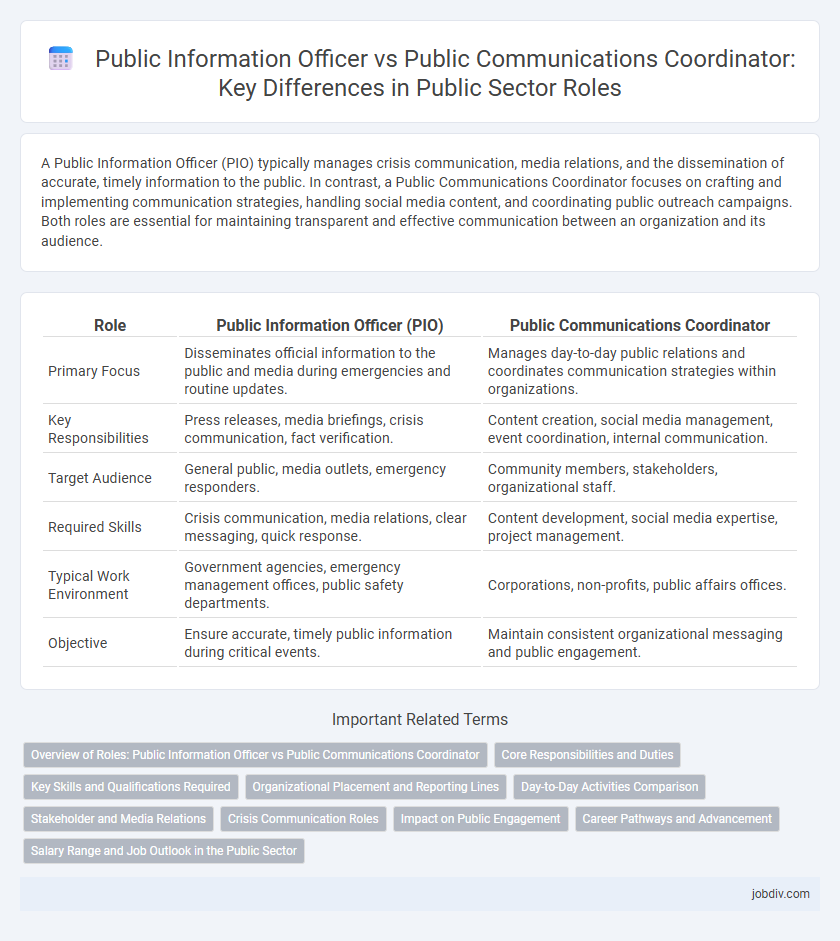A Public Information Officer (PIO) typically manages crisis communication, media relations, and the dissemination of accurate, timely information to the public. In contrast, a Public Communications Coordinator focuses on crafting and implementing communication strategies, handling social media content, and coordinating public outreach campaigns. Both roles are essential for maintaining transparent and effective communication between an organization and its audience.
Table of Comparison
| Role | Public Information Officer (PIO) | Public Communications Coordinator |
|---|---|---|
| Primary Focus | Disseminates official information to the public and media during emergencies and routine updates. | Manages day-to-day public relations and coordinates communication strategies within organizations. |
| Key Responsibilities | Press releases, media briefings, crisis communication, fact verification. | Content creation, social media management, event coordination, internal communication. |
| Target Audience | General public, media outlets, emergency responders. | Community members, stakeholders, organizational staff. |
| Required Skills | Crisis communication, media relations, clear messaging, quick response. | Content development, social media expertise, project management. |
| Typical Work Environment | Government agencies, emergency management offices, public safety departments. | Corporations, non-profits, public affairs offices. |
| Objective | Ensure accurate, timely public information during critical events. | Maintain consistent organizational messaging and public engagement. |
Overview of Roles: Public Information Officer vs Public Communications Coordinator
A Public Information Officer (PIO) primarily manages the dissemination of official information to the public and media, ensuring accuracy and transparency during emergencies or organizational updates. A Public Communications Coordinator focuses on developing and implementing communication strategies, including social media, press releases, and community outreach to promote organizational goals. Both roles require strong communication skills but differ in scope, with PIOs emphasizing crisis communication and compliance, while Coordinators handle broader public engagement and messaging campaigns.
Core Responsibilities and Duties
A Public Information Officer (PIO) primarily manages the dissemination of accurate information to the public and media, ensuring transparency and timely updates during emergencies or public events. In contrast, a Public Communications Coordinator focuses on crafting and executing strategic communication plans, maintaining consistent messaging across multiple platforms, and supporting community engagement initiatives. Both roles require strong public relations skills, but the PIO emphasizes crisis communication while the Communications Coordinator prioritizes ongoing brand consistency and outreach.
Key Skills and Qualifications Required
A Public Information Officer requires expertise in media relations, crisis communication, and public speaking, with a strong background in journalism or communications. A Public Communications Coordinator must excel in strategic messaging, social media management, and content creation, often requiring skills in marketing and digital communications. Both roles demand excellent writing abilities, attention to detail, and proficiency in handling public inquiries, but the officer focuses more on official information dissemination while the coordinator prioritizes campaign coordination and engagement strategies.
Organizational Placement and Reporting Lines
A Public Information Officer (PIO) typically operates within government agencies or emergency management departments, reporting directly to senior officials such as the Public Affairs Director or agency head, ensuring timely and accurate public messaging during crises. In contrast, a Public Communications Coordinator often works within broader organizational communications or marketing teams, reporting to the Communications Manager or Marketing Director, focusing on the coordination and dissemination of public-facing content. The PIO's role is more centered on authoritative public information and crisis response, while the Coordinator manages ongoing public engagement and media relations under a structured communications hierarchy.
Day-to-Day Activities Comparison
A Public Information Officer manages media relations, drafts press releases, and responds to public inquiries to maintain the organization's public image. A Public Communications Coordinator oversees internal communication strategies, coordinates social media content, and supports campaign execution to ensure consistent messaging. Both roles involve content creation and stakeholder engagement but differ in their focus on external versus internal communication channels.
Stakeholder and Media Relations
A Public Information Officer (PIO) primarily manages media relations by disseminating official information and handling crisis communication, ensuring accurate and timely updates to the public and media outlets. In contrast, a Public Communications Coordinator focuses on stakeholder relations by developing targeted communication strategies to engage community groups, government agencies, and internal teams, fostering collaborative partnerships. Both roles require strong communication skills but differ in their emphasis, with the PIO centered on media outreach and the Coordinator prioritizing stakeholder engagement.
Crisis Communication Roles
Public Information Officers (PIOs) lead crisis communication by delivering timely, accurate updates to the public and media, ensuring transparency and trust during emergencies. Public Communications Coordinators support PIOs by managing internal communication channels, coordinating messaging across departments, and handling logistical aspects of information dissemination. Both roles are crucial for maintaining consistent communication flow and minimizing misinformation in crisis situations.
Impact on Public Engagement
A Public Information Officer (PIO) directly manages crisis communication and government messaging, significantly shaping public trust and information accuracy during emergencies. A Public Communications Coordinator enhances outreach by strategizing content distribution across multiple media platforms, increasing visibility and participation in community programs. Both roles crucially influence public engagement, with PIOs driving trust through timely updates and Coordinators expanding reach through targeted communication campaigns.
Career Pathways and Advancement
Public Information Officers typically advance through careers in government, media relations, or public affairs, gaining expertise in crisis communication and media strategy. Public Communications Coordinators often start in entry-level roles within marketing or corporate communications, progressing towards management positions by developing skills in content creation and stakeholder engagement. Both career paths emphasize gaining experience in strategic communication, but PIOs focus more on public sector and regulatory environments while Coordinators may transition into diverse industries.
Salary Range and Job Outlook in the Public Sector
Public Information Officers in the public sector typically earn between $50,000 and $85,000 annually, reflecting their role in managing media relations and government communication strategies. Public Communications Coordinators generally have a salary range of $45,000 to $70,000, focusing on content creation and internal communication within public agencies. The job outlook for both positions remains stable, with a projected growth rate of around 6% due to increasing demand for transparent and effective public sector communication.
Public Information Officer vs Public Communications Coordinator Infographic

 jobdiv.com
jobdiv.com